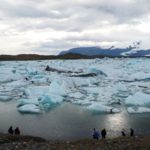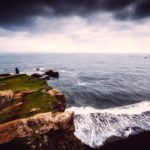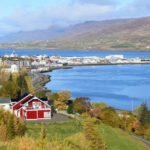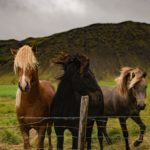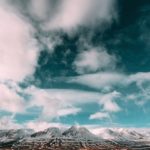Why I Traveled to the Land of Ice and Fire in the Dead of Winter
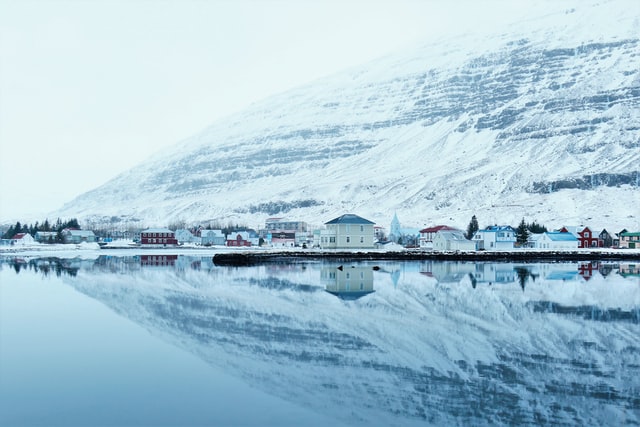
My trek to Iceland took place in the middle of winter, a time of utmost extreme weather. Being from the Northeastern US, I am no stranger to the pulse-numbing snow, cold and ice that come with winter. However, many would still ask why I might travel to Iceland in the ultimate depths of winter, a time of glacial temperatures, whiteout snowstorms, frigid squalls and just a few hours of daylight a day. The answer to me seemed obvious: what better time to visit the land of ice and fire than in the season at the epicenter of its name?
You can go to Iceland in the spring or summer, when the days are long and the sun plentiful above the greened fjords and cascading waterfalls. But one of the best aspects of this location is its utter intensity, and only the winter showcases this characteristic. The winter allows you to hear the pinprick silence of the darkness settling on ice in the middle of the tundra; to feel the utter warmth of the geothermal hot springs contrasted against the crystalline cold of the air.
I landed at 4am, arrival time for flights into Reykjavík from the east coast of the US. I had been apprehensive to book a vehicle beforehand, not knowing what the weather would be when I was there, and so waited until landing to select and book a car so that I would know exactly what the forecast would be. This was a good choice, as the weather proved to be solidly snowy but not excessively icy during my stay.
What better time to visit the land of ice and fire than in the season at the epicenter of its name?
At the rental car window I was provided with a wide variety of vehicle options, ranging from 2wd two-door sedans to souped-up 4wd SUVs made for heavy offroading. Along with the selection of vehicles came just as wide a selection of insurance options. Did I need windshield gravel coverage? Volcanic ash protection? Weighing my options, I figured I’d probably be getting into a bit of offroading, but probably not getting in the way of an erupting volcano, so I chose the best insurance for my needs and was on my way in a small 4wd SUV.
When I was attempting to reverse out of the parking lot, it became apparent that while I could go forward in the car, I could not figure out how to reverse. I discovered this while making a U-turn in a parking lot exit lane, in which I got stuck because I simply could not figure out how to back up. All rental cars in Iceland are manual, which was just fine with me because I drive a stick shift at home, but not all manual cars in the Nordic countries have a reverse gear slot.
Why I Traveled to the Land of Ice and Fire in the Dead of Winter.
Instead, you pull up on a small ring at the top of the gear shift to go in reverse. I received this tidbit of information at 4:30 am from the gentle Icelandic man who got caught behind me, ran over to my car when he saw I was stuck, and kindly reached into my window and pulled up on the ring to show me how to reverse!
And… on to Reykjavík at last. I slid through the pitch-black dark on icy roads from the airport into the city, about 45 minutes away, and stumbled into Grái Kötturinn (The Gray Cat), one of the only cafes open at that ungodly hour. I drank robust coffee and ate fried eggs, which I ate at a diner table in a snug nook surrounded by books. I leafed through a novel by Auður Ava Ólafsdóttir. Outside, the snow blew by the warm light of the cafe beyond the windows with wrought iron designs.
After an hour or two, I saw the light begin to lift in the sky, turning it from black to a bruised purple-grey. I went back to the car and dropped down onto the waterfront, where I had seen the glimpse of a beautiful, gleaming sculpture in the dark as I drove in. The evocative Sun Voyager sculpture emerged by the hint of daylight, like a phantasmic Viking boat coming out of a warrior’s dream. The snow had ceased and I went and sat on the sculpture in the cold, looking out at the snow-covered, flat, volcanic slopes of Mt. Esja across the bay.
My eyes could not drink enough of the landscape, and my spirit not enough of the energy. I hit the Ring Road for hours, travailing down every side path I could find.
It became clear by noon that daylight was not really a thing in this land of ice and fire at this time of year. The sky remained dark and set an atmosphere of constant, cozy melancholy. I walked around the city while the wind and snow sailed past me, and I ran my fingers through sheepskin slippers and thick yak rugs. I took in the colorful graffiti that covered many walls in bright colors, contrasting with the gray skies, depicting geometric polar bears, glaciers, and Nordic designs. I took photos in front of the pillared clocktower of Hallgrímskirkja before finally being able to check into my hostel and crash into the fitting slumber of a well-heated room.
I spent many days traversing the Icelandic countryside simply looking out into the landscape and marveling at the way the moss grew green on the rocks showing through in patterns on the clean white snow, at how the expanses of sharp, black volcanic stone fields ran into otherworldly, snow-striated rock peaks. The entire landscape felt unearthly and transcendental, born from interplanetary elements. I understood why this was called the land of ice and fire.
I slid down snow-laden dirt roads and pulled off by the side to creep into icy lava caves set into wideout, windswept expanses. I stood in the middle of the tundra at midnight on the Bridge Between Two Continents, looking up into the ash black of a sky that knew no end with stars.
My eyes could not drink enough of the landscape, and my spirit not enough of the energy.
When my body needed a rest after trekking the raw, snowy steppes all day, I hiked through the basalt fields from my room in quiet Grindavík up to the Blue Lagoon. I first saw the color of the water trickling through obsidian stones, milky ice-blue and mythic. In fact, I went through the rigamarole of paying for the privilege and shivered my way from the showers to the edge and slipped into those dreamlike, warm, lactescent waters, letting them envelop me in mysticism as steam rose all around me.
I rubbed the nutrient-rich clay from the pool all over my face and arms, and drifted lazily around the perimeter as the last of the gray daylight hours fell, letting my skin and soul absorb the ether of this place. In the dark, the waters took on a different hue of opaline indigo, and I swam below a footbridge of atmospheric lights, letting a waterfall splash over me from a lava face while other travelers floated past, talking in a million languages that ran together in the night under the moody purple clouds.
My eyes could not drink enough of the landscape, and my spirit not enough of the energy. I hit the Ring Road for hours, travailing down every side path I could find, making good use of the windshield and gravel coverage. In fact, I watched the Strokkur Geyser blow some 100 feet into the air straight out of a wide plateau of snow-covered ground, and stood at the edge of Gulfoss Waterfall, which poured tons of glacial water from its edges in such a heavy, internal way that it appeared the water was vanishing into the deep center of the earth.
Why I Traveled to the Land of Ice and Fire in the Dead of Winter.
However large and ethereal these moments in the land of ice and fire were, there were also even larger moments in the tiniest day-to-day aesthetics in Iceland. Boatmen working the ships in the harbors at dawn against a backdrop of glaciers and fjords; old moss-laden Viking villages built into the hillsides; Reykjavík cafes filled with steam and the aroma of strong coffee, while customers huddled close and talked in low voices among the hum.
The ever-empyreal intensity of the landscape stretching on and on outside the tightly closed door, the magma of the nation’s core pushing up through the black rock of its crust to the pillars of its stone mountain peaks, and into its moody and tumultuous skies, whose moments of clarity brought mirrored galaxies and the glimmer of the celestial.
Photo credit for Why I Traveled to the Land of Ice and Fire in the Dead of Winter by Unsplash.

